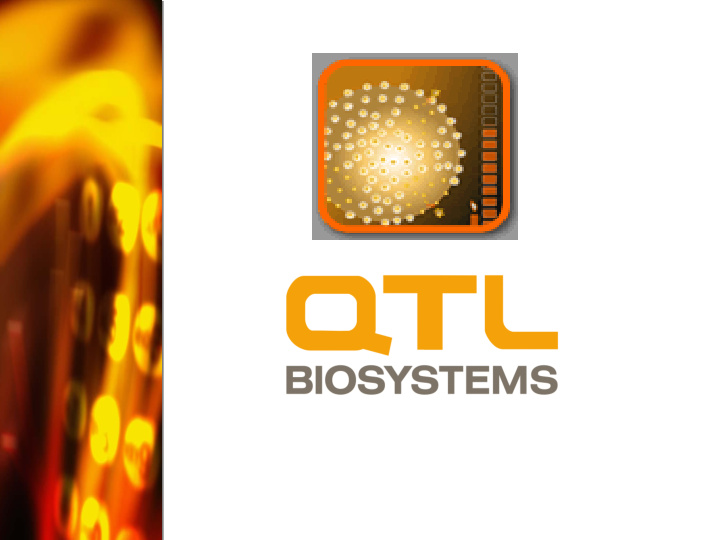



• Founded 1999 in Santa Fe, New Mexico • Proprietary technology from Los Alamos National Laboratory • Technology was developed to detect specific bio-molecular events or interactions in biochemical compound screening assays • Two business unit focuses – Drug Discovery and HTS assays – Biodefense and biotoxin detection • Company has a staff of 26, with 14 Ph.D’s
Technology : Detection system consists of a fluorescent polymer and • quencher-tether-ligand (QTL) moieties The QTL moieties consist of a quencher that quenches • polymer fluorescence, a ligand that is specifically cleaved by target enzyme, and a tether that connects the quencher and ligand When the reactive tether is cleaved by enzyme, the • quencher is released from the polymer, resulting in a quantitative signal that increases with enzyme activity or duration of the assay Inhibitors of the enzyme modulate this signal increase, • which can be tuned over a variety of sensitivity ranges as desired by target sensitivity requirements
• Technology: Recognition Sequence Recognition Sequence Biotin Biotin Quencher Quencher + + + + Enzym Enzym e e Peptide Substrate Peptide Substrate Fluorescent Polym Fluorescent Polym er er Coated M Coated M icrospheres icrospheres Biotin Binding Protein Biotin Binding Protein + + No Quench No Quench Polym Polym er Quenched er Quenched
• Technology has led to the development and release of HTS and Drug Discovery target specific assays:
• First commercially available assay: • Applied to Alzheimer’s disease research • Major constituent of senile plaques associated with Alzheimer’s is the β -amyloid peptide, generated by the activity of the enzyme β - secretase in the human brain • Combines speed with sensitivity for screening potential inhibitors against β -secretase
• Format is single-step, instantaneous, and homogenous • Fluorescense based assays • Assay can be read with most commercially available fluorescence spectrometers or multi- well plate readers • The excitation (blue) and detection (green) wavelengths are compatible with all common fluorimeters
• Typical assay workflow : – Dispense target enzyme, substrate & compounds to wells – Add sensor (fluorescent polymer) – Read fluorescence
• Advantages of technology : – Sensitivity - fluorescent polymers offer advantages over conventional small molecule-based fluorescence assays – Polymers “harvest” light effectively both by absorption and by super-quenching – even sub- nanomolar solutions of some of these material are visibly colored – Fluorescence can be detected at even lower concentrations – Polymers can be synthesized in repeat ranges of 3 to 1 000 – Polymers provide 5 to 6 times the fluorescence signal of traditional FRET-based readouts
• Advantages of technology: – Simplicity and Throughput - The assay format does not require… – Beads or washing steps – Radioactive compounds – Antibodies – Additional processing steps after all components have been added – Time to results from 1 0 minutes onwards depending on enzyme usage
• Applications: – High-Throughput Screening for Alzheimer’s drugs – Research in Alzheimer’s Disease
• Assay Performance at 20% substrate conversion: – S/B ……………1.70 – S/N ……………16 – CV % …………1.80 – Z ′ ……………..0.74 – No. of repeats …4
Enzyme concentration curve 5 1.0x10 Fluore sce nce Counts 0.8 0.6 [ Substrate] = 1.2 µ M 60 Min incubation 10 µ L volume 0.4 0 10 20 30 40 50 60 [ BACE- 1] ( nM)
Time Response 4 8x10 15 ng Enzyme 5 ng Enzyme Rela tive Fluore sce nce Counts 6 4 2 0 0 20 40 60 80 100 120 Time ( Minutes)
Other areas of interest : • Additional HTS Assays: – Caspase 3,7 – Kinase Assays: Detection Platform • Assay Development Services – Custom Enzyme and Protein-Protein Assays • Environmental Bio-detection – QTL Biosensor™ for bacterial spores and protein toxins
• Contact information: • Sales and Business Development Paul Gindlesperger Director of Sales and Marketing 505-424-1000, ext. 116 pgindlesperger@qtlbio.com www.qtlbio.com
Recommend
More recommend